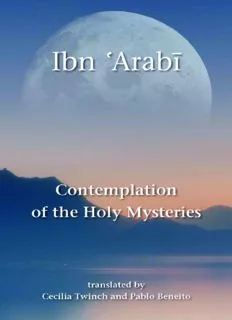
Ibn 'Arabi Contemplation of the Holy Mysteries PDF
Preview Ibn 'Arabi Contemplation of the Holy Mysteries
contemplation of the holy mysteries and the rising of the divine lights Also available from Anqa Publishing Divine Sayings: 101 ±ad¨th Quds¨, by Ibn ¡Arab¨ Translated by Stephen Hirtenstein and Martin Notcutt The Universal Tree and the Four Birds: al-Itti¢åd al-kawn¨, by Ibn ¡Arab¨ Translated by Angela Jaffray A Prayer for Spiritual Elevation and Protection: al-Dawr al-a¡lå, by Ibn ¡Arab¨ Study, translation, transliteration and Arabic text by Suha Taji-Farouki The Unlimited Mercifier: the Spiritual Life and Thought of Ibn ¡Arab¨ Stephen Hirtenstein Ibn ¡Arabi and Modern Thought: The History of Taking Metaphysics Seriously Peter Coates The Nightingale in the Garden of Love: the Poems of Üftade by Paul Ballanfat Translated from French by Angela Culme-Seymour Beshara and Ibn ¡Arabi: A Movement of Sufi Spirituality in the Modern World Suha Taji-Farouki Mu¢y¨dd¨n Ibn ¡Arab¨ contemplation of the holy mysteries and the rising of the divine lights Mashåhid al-asrår al-qudsiyya wa ma†åli¡ al-anwår al-ilåhiyya translated from the arabic by cecilia twinch and pablo beneito Based on the annotated critical edition by Souad Hakim and Pablo Beneito ANQA PUBLISHING • OXFORD Published by Anqa Publishing PO Box 1178 Oxford OX2 8YS, UK © Cecilia Twinch and Pablo Beneito 2001 First published 2001 First paperback edition, 2008 Cecilia Twinch and Pablo Beneito have asserted their moral right under the Copyright, Designs and Patents Act, 1988, to be identified as the authors of this work. All rights reserved. No part of this publication may be reproduced, stored in a retrieval system, or transmitted, in any form or by any means, without the prior permission in writing of the publisher. A CIP catalogue record for this book is available from the British Library ISBN 978 1 905937 02 8 Jacket design by Gerard Lennox Back cover: Ibn ¡Arab¨’s signature (courtesy of the Beshara School, Scotland) The assistance of Beshara Publications in the production of this book is gratefully acknowledged. Printed in the USA by Quebecor World Eusey Press Contents Acknowledgements vii Introduction 1 Spiritual journey: “Rise beyond and you will discover” 2 Mu¢y¨dd¨n Ibn ¡Arab¨ 7 This edition 11 The style and symbolism of the Contemplations 13 The Arabic language 18 contemplations: translation and notes From Ibn ¡Arab¨’s Preface 21 1 Contemplation of the Light of Existence (wuj¬d) as the Star of Direct Vision (¡iyån) rises 23 2 Contemplation of the Light of Taking (akhdh) as the Star of Affirmation (iqrår) rises 31 3 Contemplation of the Light of the Veils (sut¬r) as the Star of Strong Backing (ta¤y¨d) rises 39 4 Contemplation of the Light of Intuition (shu¡¬r) as the Star of Transcendence (tanz¨h) rises 49 5 Contemplation of the Light of Silence (ßamt) as the Star of Negation (salb) rises 55 6 Contemplation of the Light of Elevation (ma†la¡) as the Star of Unveiling (kashf) rises 59 7 Contemplation of the Light of the Leg (såq) as the Star of the Summons (du¡å¤) rises 69 8 Contemplation of the Light of the Rock (ßakhra) as the Star of the Sea (ba¢r) rises 73 v contents 9 Contemplation of the Light of the Rivers (al-anhår) as the Star of Degrees (rutab) rises 77 10 Contemplation of the Light of Perplexity (¢ayra) as the Star of Non-existence (¡adam) rises 85 11 Contemplation of the Light of Divinity (ul¬hiyya) as the Star of Låm–Alif rises 89 12 Contemplation of the Light of Uniqueness (a¢adiyya) as the Star of Servanthood (¡ub¬diyya) rises 91 13 Contemplation of the Light of the Support (¡amd) as the Star of Singularity (fardåniyya) rises 97 14 Contemplation of the Light of Argument (¢ijåj) as the Star of Justice (¡adl) rises 101 appendices 1 The manuscripts used in the edition of the text 109 2 Ibn ¡Arab¨’s preface 111 3 Ibn ¡Arab¨’s epilogue 117 4 Correspondences in Contemplation 3 121 Bibliography 127 vi Acknowledgements We would like to thank sincerely all those who have helped with the translation and production of this edition, in particular Stephen Hirtenstein, Sara Hirtenstein, Michael Tiernan, Judy Kearns, Jane Clark, Rosemary Brass, Richard Twinch, and especially Souad Hakim, who has been a constant source of inspiration and help. vii Introduction “Take it with strength and make it known to everyone you see . . .” Mu¢y¨dd¨n Ibn ¡Arab¨ makes it clear that the inspiration to write the Contemplation of the Holy Mysteries came from an extremely elevated level.1 The first instruction that occurred to him concern- ing the book was “Take it with strength and make it known to everyone you see”.2 This indicates its universal relevance, even though it consists of what may appear to be very private visions and conversations with his innermost Reality. He was also told to verify it for himself and to scrutinize it carefully, implying that it requires close attention in order for its meaning to unfold and become realized. The Contemplations3 deals with perennial questions such as the nature of existence, our relationship with the all-encompassing Reality, the limits by which we define ourselves and the Truth, and the way to happiness. Ibn ¡Arab¨ makes known the meaning and value of the human being, who is the secret of existence and the purpose of creation. He is told, “If it were not for you, the myster- ies would not exist nor would the lights shine.”4 Between the mystery of what is unseen and the clarity of what is made manifest, between majesty and beauty, compulsion and freedom, awe and intimacy, the Fire and the Garden, a line is drawn that allows for the arising of a unified perspective which 1. He states that it is from the hidden, divine Identity (huwiyya). See Ibn ¡Arab¨’s own preface to the book summarized in Appendix 2. 2. See Appendix 2. 3. The title is abbreviated to Contemplations. See pp. 21–2, n. 1. 4. Contemplation 6. 1
Description: